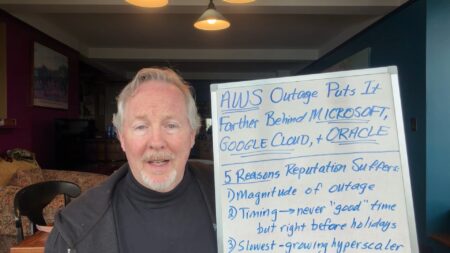With modern healthcare organizations being overwhelmed by a never-ending stream of data, devices, and apps, many organizations have turned to multi-cloud solutions.
Multi-cloud solutions — that is, using multiple cloud systems from different vendors — offer a multitude of benefits for healthcare, enabling IT teams, data analysts, and automation to create better outcomes across entire healthcare organizations. The adoption of multi-cloud systems is still in its early adoption phase in healthcare settings around the world, but already there have been tremendous results for data engineering and all relevant use-cases.
Due to the overlap of cloud providers (and their proprietary systems) as well as the continued existence of legacy systems, the need for interoperability requires sophisticated tools and new methodologies for useful data reporting. This is particularly important in healthcare, where patient data, supply chains, pharmaceutical research and more tend to be siloed sources instead of part of a holistic data ecosystem.
To gain a broader understanding of multi-cloud systems and agnostic data engineering, we’ll take a look at the following subjects:
- What Is Multi-Cloud?
- How Does Multi-Cloud Differ from Hybrid Cloud?
- Benefits of Multi-Cloud Systems in Healthcare
- Drawbacks to Healthcare Multi-Cloud
- What Role Does Multi-Cloud System Serve for Agnostic Data Engineering in Healthcare Settings?
- Challenges that Multi-Cloud Environments Present for Agnostic Data
- Using a Cloud Management Platform (CMP) for Better Data Engineering
Want to learn more about the latest insights on cloud solutions in the healthcare industry?
Register now for Cloud Wars Expo to attend Industry Cloud Battleground Live!
What Is Multi-Cloud?
Multi-cloud is the use of multiple cloud storage and computing services in a single heterogeneous architecture. Organizations typically deploy cloud services with multiple providers based on their needs for storage, security, accessibility, and so forth.
For example, a healthcare organization may use Azure for AI and ML Services but also utilize storage from Google and computing tools from Amazon Web Services (AWS).
How Does Multi-Cloud Differ From Hybrid Cloud?
Before we continue, it’s important to clarify the distinction between hybrid cloud and multi-cloud. Hybrid cloud solutions include the combination of public, private, and/or on-premises architecture in healthcare settings. Hybrid clouds typically involve on-site servers as well as cloud-based servers for security and redundancy. Healthcare organizations may have the desire to take advantage of other cloud services like AI, mobile device management, and low-code.
Comparatively, multi-cloud simply refers to the use of different cloud providers for a variety of purposes. For example, a cloud system by one service provider could be used exclusively for storing EHR services, while a patient-facing cloud system could be used for communications.
Benefits of Multi-Cloud Systems for Healthcare Insights
A multi-cloud approach offers a number of benefits to healthcare organizations:
- Compatibility with vendors and other healthcare systems
- Utilize data cloud services from multiple vendors
- Pick from a broader set of ML/AI tools
- Rapid deployment and updating
- Stronger data security and privacy
- Preventing vendor lock-in
- Overcoming latency issues
- Maintaining continuity of patient hybrid care
- Ease of scalability
- Cost-effectiveness
Drawbacks to Healthcare Multi-Cloud
Despite its many edits, assessing the drawbacks and challenges of multi-cloud paints a more realistic portrait of its real-world implementation:
- Cloud sprawl
- Shadow IT or unauthorized cloud usage
- Increased attack surface
- More complexity
- Difficult and time-consuming for IT staff during migration or deployment
- The need for creating new policy changes
- Employee training
- Disjointed cloud solutions,
- Legacy system integration with multiple cloud databanks
What Role Does a Multi-Cloud System Serve for Agnostic Data Engineering in Healthcare Settings?
As stated in the introduction, healthcare systems have a wealth of data to process, which leads to benefits and positive outcomes, if harnessed correctly. The key, however, is to provide unmitigated access for authorized users and protocols to create a better healthcare ecosystem.
The need for agnostic data engineering in a multi-cloud environment is best illustrated with a number of use-cases:
- Predictive analytics can be implemented by IT departments for a number of preemptive functions. These include reducing the usage of energy costs during hospital downtimes, performing system updates that minimize interruption to mission-critical processes, and early detection/quarantining of security threats.
- Radiologists and physicians work seamlessly with collected patient data across various cloud storages to simultaneously interpret diverse datasets, including PACS images, EHRs, RPM device data, and more.
- Researchers are able to collaborate more accurately with data taken out of silos and homogenized for more accurate metrics. Analytics can then be utilized to provide wide-ranging studies in various care communities, physician behaviors, disease patterns, and much more.
- Data scientists interrogate real-time data to inform operational decisions and patient interventions with more available data points.
- Commercial payers gain a more efficient billing system by aggregating all relevant costs across multiple departments of larger healthcare systems.
- Disparate vendors across the supply chain have a more holistic view of a healthcare organization’s current inventory and pending needs.
Challenges That Multi-Cloud Environments Present for Agnostic Data
With these promising use-cases of agnostic data in a multi-cloud environment, there are some challenges to implementing these systems in healthcare.
Redundancy for Backups and Access
Having data available in different cloud systems provides a more robust view of data — but what happens when current data is verified against out-of-date data from other sources?
While healthcare organizations spread risk across multiple cloud environments to provide redundancy and improved disaster recovery, there is still the possibility of incomplete data that not only takes up additional storage but also drains systems of efficiency as this data is processed.
Compatibility With Vendors and Other Healthcare Systems
Partner hospitals or clinics that use another vendor for different products may be on different clouds. While many clue providers emphasize interoperability, these vendors feature proprietary business models that require IT departments to tailor customized applications (via APIs) for streamlined usage.
Preventing Vendor Lock-In
With multi-cloud, organizations must be aware of being locked into a single cloud provider. For data, this means that using a singular cloud provider could potentially constrain the growth and scale of an organization if the provider is unable to meet the organization’s next-level needs.
Overcoming Latency Issues
Because public cloud providers use geographically-disparate locations, latency may be an issue. Multi-cloud is a solution to this issue, but healthcare organizations must have clear performance metrics to consistently deliver care, specifying peak times.
Maintaining Continuity of Patient Care
By design, siloed capabilities help enable a better continuity of care. If, for example, a natural disaster affects a data center, other systems continue to function — especially critical for PHI, EHR, PACS, and other data that means the difference between life and death.
With the introduction of multi-cloud, however, there are more “moving parts” of data networks that must be accounted for if data is temporarily unavailable. Unless there’s substantial overlap between systems, it may take longer to restore systems and access compromised data.
Compartmentalization
Careful planning and upkeep are needed to maintain a robust multi-cloud system. Deployment requires careful decision-making that takes into account vulnerabilities, users (ie. patient-facing public clouds, private clouds for financial records, etc.)
The danger is that “cloud sprawl” can occur, creating more access points for unauthorized access, a more cumbersome data architecture, and wasted overheads.
Using a Cloud Management Platform (CMP) for Better Data Engineering
Without question, multi-cloud environments introduce greater complexity in favor of substantial benefits for agnostic data engineering. Healthcare organizations looking to deploy a multi-cloud system for these purposes should consider a cloud management platform (CMP).
CMPs provide tools to configure, provision, monitor, and optimize multiple cloud services from multiple vendors in a single interface for greater overall efficiency. These platforms are specifically designed to remove data from cloud silos while also providing important tools and functionality, including application performance monitoring, scheduling, cloud infrastructure configuration, and more.
While IT departments can devise their own solutions, the cost of CMPs may greatly reduce operational costs and provide relevant solutions that foster wide-ranging benefits, such as collaboration with pharmaceutical manufacturers or other hospitals.
Conclusion
As you can see, multi-cloud is becoming an attractive way for healthcare organizations to deal with the explosion of digital health data. And as more organizations begin to adopt a multi-cloud solution, expect CMPs to become more common as the need for agnostic data becomes a greater priority.
Want to gain more insights from Cloud Wars Expo?
Starting on July 20th, more than 40 hours of on-demand cloud education content will be available for free to Acceleration Economy Subscribers.








